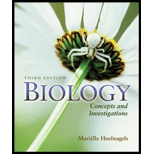
Concept explainers
Which of the following is NOT a characteristic of all protists?
- a. Unicellular
- b. Cells containing membrane-bounded organelles
- c. Cells containing a nucleus
- d. Eukaryotic
Introduction:
Protists are single celled eukaryotes. A few forms are multicellular. Protists often have cellular organelles and they demonstrate both animal and plant like characteristics. Protists can be heterotrophic or autotrophic.
Answer to Problem 1MCQ
Correct answer:
The protists can be multicellular like algae, kelp or seaweed that feed, provide shelter, and oxygen for numerous underwater ecosystem. Therefore, option a. is correct.
Explanation of Solution
Reason for the correct statement
Protista is a eukaryotic unicellular or multicellular organisms that have membrane bound organelles and nucleus. Protists can be heterotrophic, autotrophic or saprotrophic and divided into three major groups; protozoans, algae, and fungus- like protists.
Option a. is given as “unicellular”.
As, “most of the protists are unicellular, for example Paramecium; some are small multicellular colonies, for example Volvox; and some are large multicellular colonies, for example Kelp”, is the right answer.
Hence, option a. is correct.
Reasons for the incorrect statements:
Option b. is given as “cells containing membrane-bounded organelles”.
Protists are made up of eukaryotic cells and each cell contains the membrane bound organelles. So, it is a wrong answer.
Option c. is given as “cell containing a nucleus”.
Protists are made up of eukaryotic cells, each cell containing nucleus and other organelles. So, it is a wrong answer.
Option d. is given as “eukaryotic”.
Protists are the simplest eukaryotic cell that can be unicellular or multicellular. So, it is a wrong answer.
Hence, options b., c., and d., are incorrect.
Protists are the eukaryotic organisms that include all the eukaryotes except for the plants, fungi, animals.
Want to see more full solutions like this?
Chapter 18 Solutions
Biology: Concepts and Investigations
Additional Science Textbook Solutions
General, Organic, and Biological Chemistry - 4th edition
Microbiology Fundamentals: A Clinical Approach
Human Physiology: An Integrated Approach (8th Edition)
Biochemistry: Concepts and Connections (2nd Edition)
- Explain in a small summary how: What genetic information can be obtained from a Punnet square? What genetic information cannot be determined from a Punnet square? Why might a Punnet Square be beneficial to understanding genetics/inheritance?arrow_forwardIn a small summary write down:arrow_forwardNot part of a graded assignment, from a past midtermarrow_forward
- Noggin mutation: The mouse, one of the phenotypic consequences of Noggin mutationis mispatterning of the spinal cord, in the posterior region of the mouse embryo, suchthat in the hindlimb region the more ventral fates are lost, and the dorsal Pax3 domain isexpanded. (this experiment is not in the lectures).a. Hypothesis for why: What would be your hypothesis for why the ventral fatesare lost and dorsal fates expanded? Include in your answer the words notochord,BMP, SHH and either (or both of) surface ectoderm or lateral plate mesodermarrow_forwardNot part of a graded assignment, from a past midtermarrow_forwardNot part of a graded assignment, from a past midtermarrow_forward
 Biology (MindTap Course List)BiologyISBN:9781337392938Author:Eldra Solomon, Charles Martin, Diana W. Martin, Linda R. BergPublisher:Cengage Learning
Biology (MindTap Course List)BiologyISBN:9781337392938Author:Eldra Solomon, Charles Martin, Diana W. Martin, Linda R. BergPublisher:Cengage Learning
 Concepts of BiologyBiologyISBN:9781938168116Author:Samantha Fowler, Rebecca Roush, James WisePublisher:OpenStax College
Concepts of BiologyBiologyISBN:9781938168116Author:Samantha Fowler, Rebecca Roush, James WisePublisher:OpenStax College Biology: The Dynamic Science (MindTap Course List)BiologyISBN:9781305389892Author:Peter J. Russell, Paul E. Hertz, Beverly McMillanPublisher:Cengage Learning
Biology: The Dynamic Science (MindTap Course List)BiologyISBN:9781305389892Author:Peter J. Russell, Paul E. Hertz, Beverly McMillanPublisher:Cengage Learning Biology 2eBiologyISBN:9781947172517Author:Matthew Douglas, Jung Choi, Mary Ann ClarkPublisher:OpenStax
Biology 2eBiologyISBN:9781947172517Author:Matthew Douglas, Jung Choi, Mary Ann ClarkPublisher:OpenStax Biology: The Unity and Diversity of Life (MindTap...BiologyISBN:9781305073951Author:Cecie Starr, Ralph Taggart, Christine Evers, Lisa StarrPublisher:Cengage Learning
Biology: The Unity and Diversity of Life (MindTap...BiologyISBN:9781305073951Author:Cecie Starr, Ralph Taggart, Christine Evers, Lisa StarrPublisher:Cengage Learning





